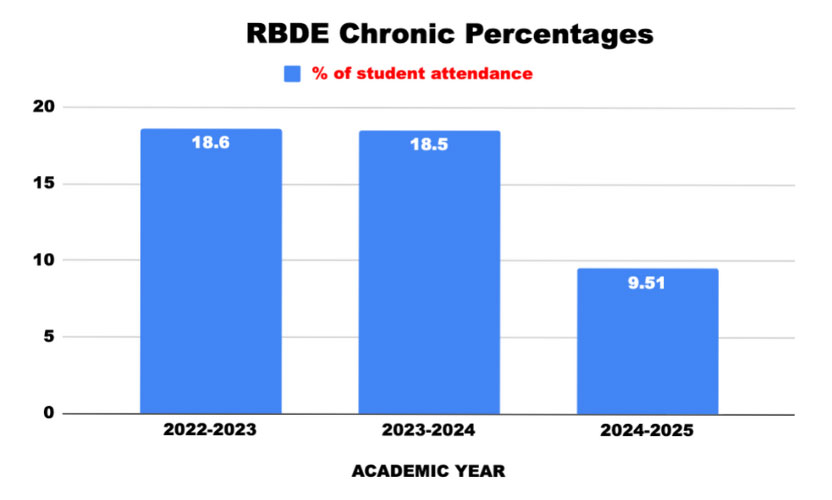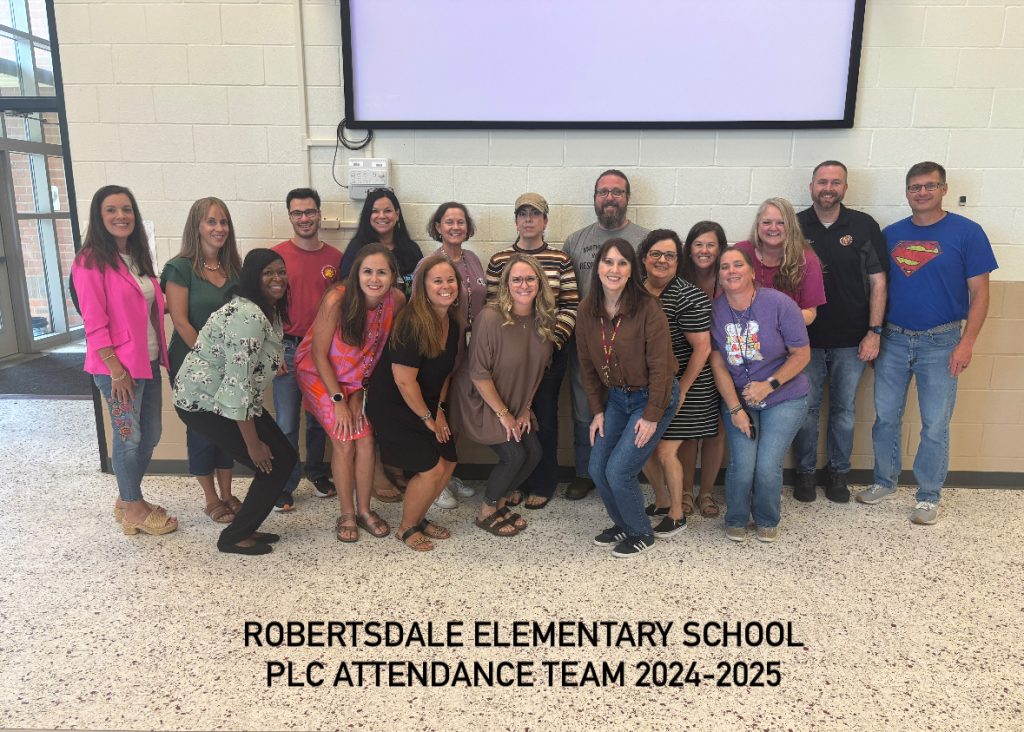“It is now very clear to me that when talking about school improvement, the number one step is getting kids to school. You can work on other things at the same time but that’s number one. If students aren’t consistently in class, then they’re not going to learn. … This data point is the most significant that I’ve tackled since I’ve been a school administrator.”
– Will Duncan, principal, Robertsdale Elementary School, Alabama
Located in the rapidly growing rural and suburban community of Baldwin County Alabama, Robertsdale Elementary serves almost 1040 students prek-6th. Almost all students are living in poverty. A quarter qualify for special education services. A fifth are English language learners. While 60.19% of students are White, a large percentage (19%) are Asian, (14.9%) are Hispanic, another 10.48% are Black and 13.65% identify as mixed race.
 Last year, in the 2024-25 school year, Robertsdale reduced its chronic absence rate to 9.51% from the 18.5% rate in the prior two school years. This represents an impressive 49% decrease in just one year!
Last year, in the 2024-25 school year, Robertsdale reduced its chronic absence rate to 9.51% from the 18.5% rate in the prior two school years. This represents an impressive 49% decrease in just one year!
Attendance Works spoke with principal Will Duncan and school counselor Shannon Rubio to find out what made this possible. Together they shared their inspiring story of change. While everyone in the school recognizes there is still work to be done, they are proud and energized by this progress.
Realizing that schools can tackle attendance
Principal Will Duncan shared that when counselor, Shannon Rubio, first walked into his office proposing to work on attendance, he wasn’t in favor, even though he understood it was a problem. “I wasn’t drinking the Kool-Aid,” Duncan said. “I thought it would just take resources away from other things we wanted to do. I didn’t think you could do anything about it.”
But Rubio was extremely passionate about addressing chronic absence, so the principal agreed to try. Rubio led an essential component of the school improvement process; her leadership freed him up to look at and address the big picture. “When I tell people what we’ve done, they don’t understand, because everybody typically is where I was. We think that attendance is not something you can really improve, because it’s family, it’s the community. It’s what they’ll allow. And I was wrong,” he says now. Rubio says she is grateful for the level of autonomy and trust Duncan gave her in leading this initiative. “Our school would not be where it is today without our principal’s leadership,” she said.
“The beauty of our attendance improvement initiative was the true collaboration of all of the staff. Each individual contribution made an impact on moving the needle,” Rubio added. Counselor Serena Forrest was a big contributor to the overall effort.
Engaging the entire community in a year long, data informed, effort
Robertsdale leveraged the school’s commitment to a professional learning community (PLC) process to create and execute a year-long plan that included the insights, skills and assets of the entire community. Below are the key actions in chronological order by month of the year.
September 2024: Taking On Attendance
- Leaning into Attendance Awareness Month, the Assistant Principal Christina Ardion encouraged Rubio to add information about attendance to morning announcements. This sparked Rubio’s interest in learning about chronic absence.
- After finding the Attendance Works website through a Facebook group for counselors, Rubio began to shift her own framework from “I don’t have control to maybe I do. Maybe we can motivate students.”
- After getting approval from the principal, Rubio organized a PLC team to tackle absenteeism. The group set a goal of reducing chronic absence to below 10%, meaning they needed to move 85 students out of chronic absence.
October 2024: Convening the Team
- Rubio invited volunteers to join a PLC charged with meeting monthly to develop and implement a plan for improving attendance. Nearly 15 members signed up, including the school counselors, site administrators, special education supervisor, nurses, teachers and the social worker, as well as a mental health facilitator and counseling supervisor for the county.
- During the first meeting at the end of October, Rubio shared the school data, the research on why chronic absence matters, key concepts including the difference between truancy and chronic absence, and Alabama’s commitment to reduce chronic absence by participating in The 50% Challenge. As the PLC team discussed the four PLC questions designed to improve student learning and engagement, they determined interventions and strategies that they believed would be most effective for their students. Rubio paid explicit attention to ensuring that everyone felt they had a voice and their input was valued.
November: Engaging Parents
- Recognizing the crucial importance of engaging parents as partners, Robertsdale held a school wide parent meeting to share why addressing chronic absence was critically important for students and the role for parents in attendance improvement efforts. Attracting nearly 200 family members, the event was a huge success.
- Planning for the meeting included extensive outreach, and securing and publicizing the availability of $700 in door prizes from local businesses including the local grocery store.
- During the event, they shared data revealing that 185 students missed 18 or more days the prior year, and showcased a 3 minute video created by Assistant Principal Dena Armbrecht. The video featured Robertsdale students explaining chronic absence and why showing up to school matters. Duncan also explained how a high level of chronic absence would lead the school to receive a lower grade in the state report card. The goal of the meeting was to replace the prevalent sense of complacency and create a shared schoolwide commitment to improving attendance, Duncan said.
December: Exploring Incentives
- The PLC attendance team began exploring how incentives could be used more strategically. They realized, however that rewarding kindergarteners for showing up for an entire month was too long of a period to engage and motivate students. The team switched to bi-weekly incentives for kindergarten. The chronic absence rate in kindergarten went from 35% in 2023-24 to 20% at the end of 2024-25.
- Team members asked teachers about what they thought would really motivate the students. Extra recess time was especially a winner! Because kindergarten and 6th grade struggled the most with regular attendance, the team focused on these grades in December and rewarded classes that reached 95% attendance with extra recess. The insights gained from this smaller experiment informed the school-wide approach to attendance incentives adopted in January.
January and February: Launching Mentoring
- In addition to incentives, the team began developing a system for intentional mentoring that has been among the most successful strategies and led to huge attendance improvements between January and May.Counselor Rubio created a list of the chronically absent students and divided them into groups to be mentored by attendance team members. The mentors agree to having a personalized, one-minute meeting with each student, to share the student’s attendance data, set a goal and agree to stay connected through the remainder of the year.
“Once children started coming to school more consistently, I visually saw an improvement in their affect and demeanor ,” Rubio said. “One of my students came to me in January. She looked tired and not motivated to be there. I shared that she had missed 13 days of school and had a history of chronic absence. But she was in a fog and didn’t know it.” After discussing the value of good attendance, we set a goal. By March, she’d only missed one additional day. By May, she only missed one more day. “She seemed happier. I believe her improved attendance created a better quality of life for her,” Rubio said.
March – Leveraging March Madness
- The team created its own March Madness attendance competition – pitting preK-2nd against 3rd-6th grades. The grades with the highest levels won extra recess on the playgrounds and a popcorn party. In the end, the difference was less than percentage, but the contest created a sense of belonging and was fun, Rubio said.
April – Sustaining the Momentum
- The class in each grade level with the highest percentage won a donut and recess party.
May – Ending the Year Strong
- For the attendance dip expected in the spring months, the team created a “Sweet 16” incentive on the last day of school. Every student who attended all 16 days of school in May earned ice cream sundaes. Even students who had been chronically absent earlier in the year could participate. The ice cream supplies were donated by a local men’s group, and parents and staff helped make the event a success.
- The school held end-of-the year attendance celebrations on the last day of school. All students who attended for 95% of days over the year were invited to the Atten-DANCE. Certificates and local prizes were given to the 30 students with perfect attendance for the whole year.
Key Take Aways
Robertsdale’s success reflects several key attributes of their work. First, from the beginning, the school created opportunities for local business and civic groups that might have resources to address basic needs. Soliciting for the prizes and incentives was one opportunity to engage local business and civic groups.
The PLC process allowed the school to draw upon insights from a wide range of staff.
Second, the school ensured consistent messaging throughout the year and across everyone in the school community. In addition to the activities already mentioned, the principal encouraged all teachers to call students to check-in if a student missed more than a day of school. Assistant Principal Nick Hemmert also began discussing attendance whenever a disciplinary matter came up.
Third, the school used data to inform action. Everyone working on attendance used data to identify which and how many students needed the most support, and then intentionally supported these students through the last day of school. They used data to identify the grades that needed the most support and assess how to improve the impact of their activities.
A final note
As an organization dedicated to helping everyone across the country take action to improve attendance, Attendance Works was grateful to learn that our website helped to support Robertsdale’s impressive work.
We reached out to talk with the school after receiving an email from Shannon Rubio with this comment:
This year, our team made significant strides in addressing chronic absenteeism, and I wanted to extend my sincere gratitude for the invaluable resources provided by Attendance Works.
Your website served as our primary guide and was instrumental in helping us establish an effective attendance team. The research, tools, and intervention strategies available through Attendance Works informed our approach and shaped the actions we implemented on our campus.

The Robertsdale Elementary PLC Attendance Team